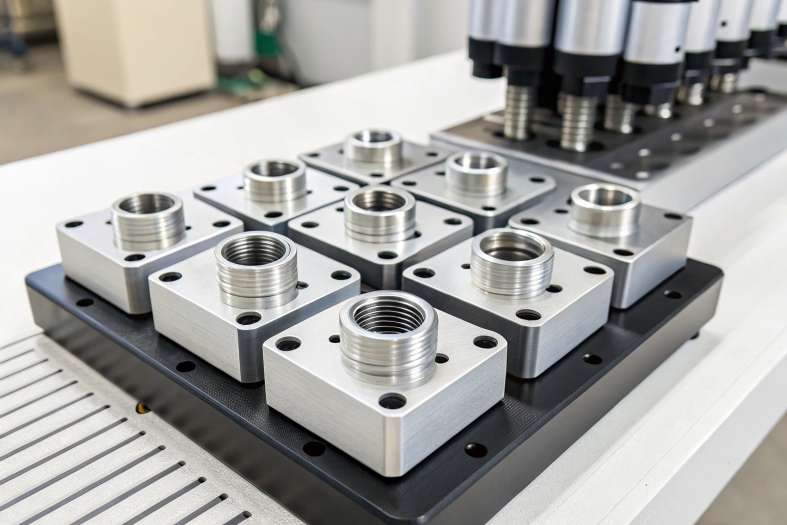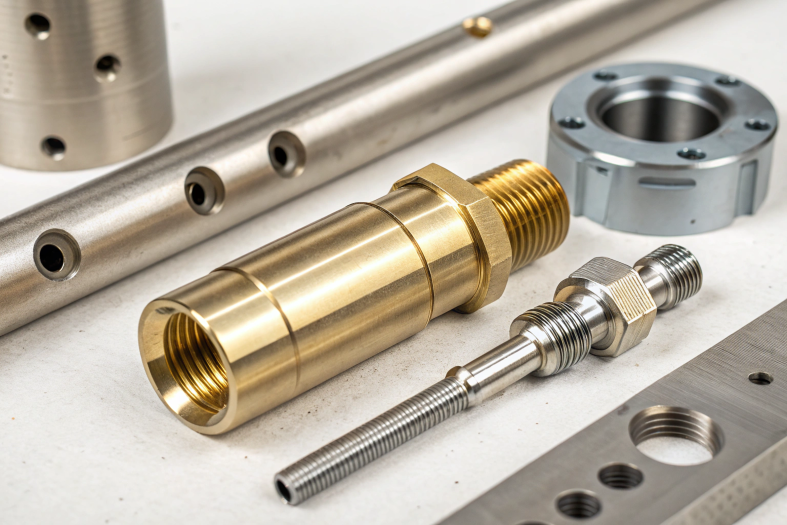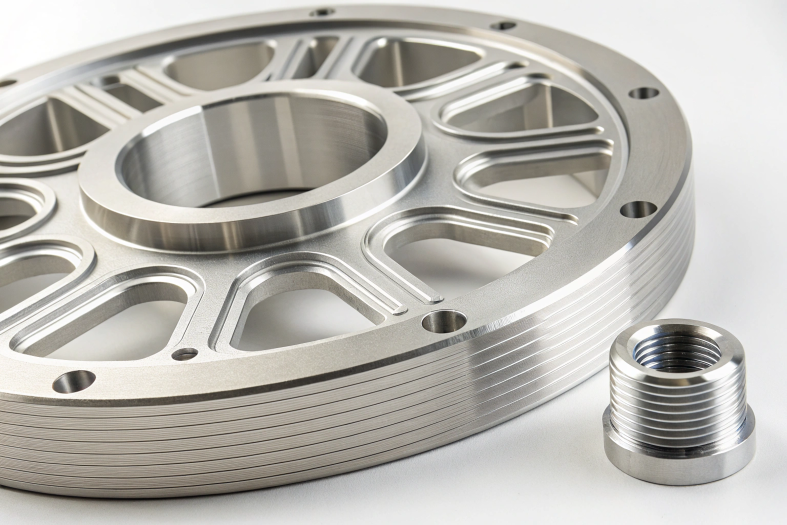When it comes to CNC machining, surface finishes are crucial for determining the final part’s performance, durability, and aesthetics. CNC machined parts often require specific surface treatments to meet industry standards and functional requirements. This article explores the various types of surface finishes commonly used in CNC machining, as well as the critical surface finish indicators that define part quality.
Direct Answer:
Common CNC surface finishes include anodizing, electropolishing, powder coating, brushed finish, bead blasting, polishing, painting, and plating. These finishes offer unique benefits such as enhanced durability, corrosion resistance, aesthetic appeal, and functionality.

Why Are Surface Finishes Important in CNC Machining?
Surface finishes are important for several reasons:
-
Aesthetic and Functional Considerations: High-quality surface finishes improve the visual appeal and functionality of parts. Industries like automotive and electronics often require parts with polished or anodized finishes.
-
Durability and Protection Against Corrosion: Certain finishes, like anodizing and plating, protect materials from corrosion and environmental degradation, increasing longevity.
-
Enhancing Performance and Longevity: Some finishes enhance the surface hardness or resistance to heat, friction, or chemicals, which improves part performance.
Common Types of Surface Finishes
Anodizing
-
What is Anodizing?
An electrochemical process that forms a durable oxide layer on materials like aluminum, enhancing both appearance and durability. -
Benefits: Anodizing improves corrosion resistance, wear properties, and the ability to add color to the material. It’s commonly used in industries like aerospace, automotive, and electronics.
-
Applications: Ideal for aluminum, titanium, and magnesium, anodizing is frequently used in parts exposed to harsh conditions, such as engine components and structural parts.
Electropolishing
-
Process Overview: Electropolishing is an electrolytic process that removes a thin layer of material from the surface, improving smoothness and brightness.
-
Applications: Used in medical devices and aerospace components for its ability to create corrosion-resistant surfaces that are easy to clean.
Powder Coating
-
What is Powder Coating?
A dry powder is applied to a part, then heated to form a hard, durable coating. -
Pros and Cons: Powder coating offers superior durability, resistance to chipping, and a wide range of colors, but may not be suitable for parts requiring high precision.
-
Applications: Common in automotive, architecture, and heavy machinery industries.
Brushed Finish
-
What is Brushed Finish?
Achieved by polishing the material’s surface with abrasive pads, creating fine lines for a textured appearance. -
Applications: Often used for consumer goods, such as appliances, electronics, and automotive parts, primarily for aesthetic purposes.
Bead Blasting
-
Description: Involves blasting the surface with small beads to create a matte or satin finish.
-
Applications: Used in industries like automotive, aerospace, and medical to remove surface contaminants and enhance texture.
Polishing
-
What is Polishing?
A process that smooths a surface to a high-gloss, mirror-like finish, often used when appearance is critical. -
Applications: Essential in industries like jewelry, high-end automotive, and medical equipment where a shiny, smooth appearance is required.
Painting
-
What is Painting?
Paint is applied to create a protective layer against corrosion and enhance the appearance of the part. -
Applications: Common for parts exposed to harsh conditions like moisture, UV radiation, and chemicals, especially in automotive and aerospace industries.
Plating
-
What is Plating?
A thin layer of metal (e.g., chrome, nickel, gold) is applied to improve appearance, corrosion resistance, and functionality. -
Applications: Used widely in automotive, electronics, and aerospace to improve part performance and aesthetics.

Surface Finish Indicators in CNC Machining
The surface finish of CNC machined parts is often characterized by surface roughness indicators that define the texture and quality of the part. These indicators are essential for evaluating how well the part meets functional and aesthetic requirements. The most common surface roughness indicators used in CNC machining include RA (Roughness Average), RZ (Average Maximum Height of the Profile), Rt (Total Height of the Profile), Rq (Root Mean Square Roughness), and Waviness.
1. RA (Roughness Average)
-
Definition: RA is the arithmetic mean of the absolute deviations from a reference line across a given length. It is the most widely used roughness indicator in CNC machining.
-
Applications: RA values are ideal for general surface quality assessments where extreme precision is not critical.
- Low RA Values (e.g., 0.05 μm to 1 μm) are used in precision industries such as aerospace and medical devices.
- Higher RA Values (e.g., 5 μm to 10 μm) are used in standard industrial applications.
-
Influencing Factors: Cutting speed, tool wear, and material hardness significantly impact the RA value.
2. RZ (Average Maximum Height of the Profile)
-
Definition: RZ measures the average difference between the highest peak and the lowest valley over a series of sampling segments.
-
Applications: RZ is often used in precision machining for parts that require tight fitting, such as seals or assembly components.
- RZ Values typically range from 10 μm to 50 μm for industrial applications.
-
Influencing Factors: Tool type and surface processing can reduce RZ values, improving part fit and functionality.
3. Rt (Total Height of the Profile)
-
Definition: Rt measures the total height difference between the highest and lowest points across the entire surface profile.
-
Applications: Important for rough castings and parts that may have noticeable surface irregularities.
4. Rq (Root Mean Square Roughness)
-
Definition: Rq measures surface roughness using the square root of the mean squared deviations from the average line. It is more sensitive to large surface variations compared to RA.
-
Applications: Used for precision components where surface integrity and fatigue resistance are critical.
-
Typical Rq Values: Precision components typically range from 0.05 μm to 1 μm, while standard components range from 1 μm to 10 μm.
5. Waviness
-
Definition: Waviness refers to large-scale variations in the surface profile caused by factors such as machine vibrations or tool deflection.
-
Applications: Important in applications requiring smoothness and uniformity, such as sealing surfaces.
Factors to Consider When Choosing a Surface Finish
When selecting a surface finish for CNC machining, several factors must be considered:
- Material Compatibility: Some finishes, like anodizing, work best with specific materials (e.g., aluminum).
- Desired Appearance: Whether a matte, glossy, or textured finish is required will influence the choice.
- Performance and Environmental Factors: Some finishes are better suited for parts exposed to wear, heat, or chemicals.
Real-World Applications of Surface Finishes
-
Automotive: Parts like engine components and body panels require finishes that balance durability and aesthetics, such as anodizing and powder coating.
-
Aerospace: Parts require finishes that enhance strength and resistance to heat and corrosion, such as electropolishing and plating.
-
Medical: Medical devices like surgical tools and implants require finishes like electropolishing or bead blasting to ensure biocompatibility and hygiene.

Conclusion
Choosing the right surface finish is critical for ensuring that CNC machined parts meet both functional and aesthetic requirements. The surface finish not only influences the appearance of a part but also its durability, performance, and ability to withstand harsh conditions. Whether you need corrosion resistance, a polished look, or a specific texture, understanding the types of surface finishes and roughness indicators will help you make the best decision for your CNC machining project.
FAQ:
What is the typical surface finish for CNC?
The typical surface finish for CNC machining varies depending on the application and the material. However, common surface finishes include:
- RA (Roughness Average): Usually ranging from 0.4 μm to 3.2 μm for general industrial applications.
- Brushed Finish: Often used for aesthetic purposes in consumer products.
- Anodizing: Common for aluminum parts, offering durability and corrosion resistance.
- Polishing: Achieved for smooth, shiny surfaces, used in high-end products.
What are the types of surface finishes?
There are several types of surface finishes commonly used in CNC machining:
- Anodizing: Electrochemical process to form an oxide layer for durability and appearance.
- Electropolishing: Removes a thin layer of material to create a smoother, shiny finish.
- Powder Coating: A dry powder applied and cured to form a tough coating.
- Brushed Finish: Creates fine lines on the surface for texture.
- Bead Blasting: Small beads are blasted to create a matte or satin finish.
- Polishing: Achieves a smooth, glossy finish, often for aesthetic applications.
- Painting: Adds protective and aesthetic layers to the surface.
- Plating: Metal layers (e.g., chrome, nickel) are applied for protection and appearance.
What is a 20 RA surface finish?
A 20 RA surface finish refers to a roughness average of 20 micrometers (μm). This surface finish is relatively rough and typically used in industrial applications where precision is less critical but a basic level of roughness is acceptable. It's commonly seen in castings, structural components, or other parts where smoothness isn't a primary concern.
What is a 0.4 RA surface finish?
A 0.4 RA surface finish indicates a roughness average of 0.4 micrometers (μm). This is a relatively smooth finish often used in high-precision applications like aerospace, medical devices, or high-quality consumer goods. Achieving a surface finish of 0.4 RA requires advanced machining techniques and often results in parts with better performance and aesthetics.


